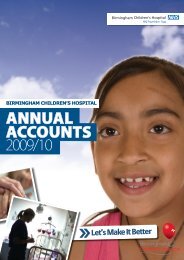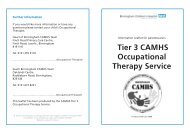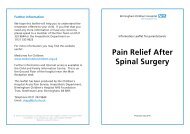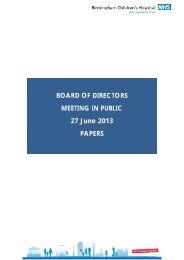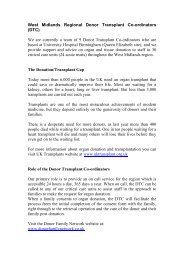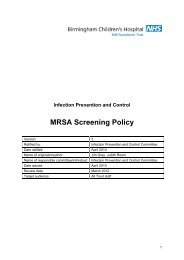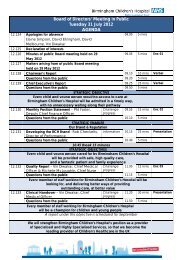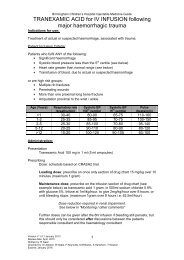Nurses Day! - Birmingham Children's Hospital
Nurses Day! - Birmingham Children's Hospital
Nurses Day! - Birmingham Children's Hospital
Create successful ePaper yourself
Turn your PDF publications into a flip-book with our unique Google optimized e-Paper software.
l There are structured processes in place for<br />
incident reporting and the investigation of<br />
Serious Incidents Requiring Investigation<br />
(SIRIs), complaints and litigation cases. Regular<br />
audits are undertaken of these processes to<br />
ensure they are appropriately followed and are<br />
effective. The outcomes of these audits are<br />
reported to the Clinical Risk and Quality<br />
Assurance Committee.<br />
l Incident reporting is openly encouraged across<br />
the Trust through training, the use of online<br />
incident reporting, and the communication of<br />
positive outcomes as a result of reporting of<br />
incidents, errors and near misses. Ward<br />
inspections to check compliance with CQC<br />
standards provide assurance that staff know how<br />
to repor incidents.<br />
l A non-executive director is invited to participate<br />
in the Root Cause Analysis of every SIRI. This<br />
helps ensure a good Board level understanding<br />
of risk management processes in the<br />
organisation.<br />
l All papers presented to the Board of Directors<br />
and Board committees contain an assessment of<br />
key regulatory or statutory impacts, including<br />
equality, diversity and human rights and<br />
compliance with standards including NHS<br />
Litigation Authority risk management standards<br />
and CQC essential standards of quality and<br />
safety.<br />
l The Trust attends and submits a performance,<br />
compliance and risk report to the Trust’s<br />
Commissioner’s monthly Clinical Quality Review<br />
Group.<br />
l A representative of the Trust’s Commissioners is<br />
invited to attend the Trust’s monthly Clinical Risk<br />
and Quality Assurance Committee and is invited<br />
to participate in the Root Cause Analysis of<br />
SIRIs.<br />
l All quality initiatives and Cost Improvement<br />
Plans require a quality impact assessment,<br />
which is scrutinised by the Chief Medical Officer<br />
or Chief Nursing Officer before approval.<br />
l Risk appetite is determined in relation to specific<br />
matters reviewed by the Board through detailed<br />
consideration of risk and benefit analysis.<br />
Key Quality Governance Arrangements<br />
The Trust has continued to refine its approach to<br />
the analysis of incidents, potential incidents and<br />
near misses, in order to identify and communicate<br />
learning points and necessary actions. This<br />
commitment to developing an environment of<br />
honesty and openness, where mistakes and<br />
untoward incidents are identified quickly and dealt<br />
with in a positive and responsive way, has been<br />
successful in engaging clinical staff. This approach<br />
to learning is also informed by various sources<br />
of information including surveys, patient and staff<br />
feedback, service reviews, and clinical audits.<br />
A regular Safety Dashboard is produced for<br />
each Clinical Directorate, which incorporates an<br />
overview of data such as incident reports, SIRIs,<br />
complaints and Nursing Care Quality Indicators<br />
(NCQI) performance per ward/department to<br />
highlight potential issues or concerns about<br />
safety or quality of services. The dashboard<br />
allows an aggregated review and comparison of<br />
these metrics against each individual ward and<br />
department and incorporates a series of defined<br />
‘triggers’ which, in combination, may indicate<br />
problems with safety or quality in a specific area.<br />
This allows the Directorate Management Teams<br />
and Board committee responsible for safety to<br />
focus attention where it may be required and acts<br />
as an early warning system. From 2012, the Safety<br />
Dashboard has also identified the departments<br />
implementing a Cost Improvement Plan (CIP) so<br />
an assessment can be made as to whether the<br />
project is affecting quality and safety. Workforce<br />
information is also included, as indications of low<br />
staff engagement can act as an early warning<br />
about a possible impact on our services.<br />
In 2011/12 a Patient Safety Strategy was<br />
developed which maps out the Trust’s journey<br />
towards safer care. The Strategy is updated each<br />
year and sets out a series of clearly defined,<br />
measureable safety targets to achieving the Trust’s<br />
aim to eliminate any less than perfect care. These<br />
targets are produced through a process of risk<br />
analysis, identifying areas for improvement through<br />
data sources such as SIRIs, incident reporting,<br />
complaints, litigation and patient experience<br />
feedback, as well as national guidance and best<br />
practice benchmarking. We believe that focussing<br />
our efforts on a targeted list of specific projects will<br />
have a significant impact on the amount of harm<br />
which is suffered by our patients.<br />
The Trust’s Values – which were agreed in<br />
consultation with staff – have been embedded<br />
during 2012/13 in our recruitment, induction<br />
and appraisal processes. This ensures that all<br />
new staff demonstrate our Values and that the<br />
behaviours of all staff and the decisions that we<br />
make are rooted in our values. Commitment to<br />
these values – respect, trust, compassion, courage<br />
and commitment - also encourages openness<br />
and transparency, which supports robust quality<br />
governance arrangements centred on learning.<br />
The Trust commissioned an external review of<br />
its governance structures in 2011/12 to ensure<br />
they are fit for purpose and provide the Board<br />
of Directors with sufficient, high quality, timely<br />
information. As a result of this review, the<br />
governance structure was redesigned to include 2<br />
new Board Committees:<br />
l Quality Committee, the aim of which is to<br />
provide strategic direction and overview of all<br />
issues related to the quality of care and service<br />
provision, allowing integrated quality reporting to<br />
the Board of Directors.<br />
l Finance and Resources Committee, to review all<br />
matters relating to resources, including finance,<br />
investment, workforce and information<br />
technology, and to provide strategic direction on<br />
negotiating the risk environment.<br />
This new structure was implemented in 2012/13<br />
and its effectiveness was assessed at the end of<br />
the year.<br />
The Quality Report provides an overview of<br />
the main indicators of quality across the Trust,<br />
including high risks, incidents, mortality, patient<br />
experience, safeguarding and infection control, as<br />
well as progress against our Safety Strategy and<br />
quality projects such as the Safety Thermometer<br />
and our programme of Quality Walkabouts.<br />
The report is considered every month by the<br />
Board alongside our Resources Report, which,<br />
in addition to giving details of the Trust’s financial<br />
performance, examines the Trust’s activity<br />
levels, including the way people are accessing<br />
our services; and workforce indicators, such as<br />
sickness levels, turnover, and mandatory training<br />
and appraisal targets, to allow an assessment<br />
of the impact of activity levels on our staff. The 2<br />
reports together provide a broad perspective of<br />
all the factors that make up the Trust’s system of<br />
internal control.<br />
In February 2013 our Internal Auditor completed<br />
a review of the Trust’s Quality Governance<br />
arrangements that ensure compliance with<br />
Monitor’s Quality Governance Framework. This<br />
review found that the Trust meets Monitor’s criteria,<br />
146 147<br />
BACK TO CONTENTS PAGE<br />
and provides ‘significant assurance’ that the Trust’s<br />
arrangements are sound. A small number of areas<br />
were identified which could be improved, and<br />
we are implementing the recommendations of the<br />
Internal Auditor so we can ensure that our quality<br />
governance arrangements are the best they can be.<br />
In 2012 both the Trust’s locations, at Parkview and<br />
at Steelhouse Lane, received an unannounced<br />
inspection from CQC. The review of the CAMH<br />
Services at Parkview found full compliance with the<br />
standards reviewed.<br />
The review at Steelhouse Lane found a minor noncompliance<br />
with standard 14: Supporting workers.<br />
This finding related to a concern raised by some<br />
Theatre staff about the way they were supported,<br />
particularly in relation to the implementation of a<br />
new way of working in Theatres.<br />
In response we have changed the way we are<br />
implementing the new process, and have engaged<br />
closely with the Theatre staff to fully understand<br />
their concerns and address them. In addition, we<br />
have developed new ways of reporting potential<br />
workforce issues to the Board and its committees<br />
to identify as early as possible when our staff<br />
may be feeling unhappy, unsupported, or under<br />
pressure. We have also added further workforce<br />
metrics to the Safety Dashboard to help us better<br />
identify when a ward or department may be coming<br />
under pressure, and where that could have an<br />
impact on the quality of care.<br />
The Trust is fully compliant with the registration<br />
requirements of the Care Quality Commission.<br />
As an employer with staff entitled to membership of<br />
the NHS Pension Scheme, control measures are in<br />
place to ensure all employer obligations contained<br />
within the Scheme regulations are complied with.<br />
This includes ensuring that deductions from salary,<br />
employer’s contributions and payments into the<br />
Scheme are in accordance with the Scheme<br />
rules, and that member Pension Scheme records<br />
are accurately updated in accordance with the<br />
timescales detailed in the Regulations.<br />
Control measures are in place to ensure that all<br />
the Trusts obligations under equality, diversity and<br />
human rights legislation are complied with.<br />
The Trust has undertaken risk assessments and<br />
Carbon Reduction Delivery Plans are in place<br />
in accordance with emergency preparedness<br />
and civil contingency requirements, as based<br />
on UKCIP 2009 weather projects, to ensure<br />
that this organisation’s obligations under the<br />
Climate Change Act and the Adaptation Reporting<br />
requirements are complied with.




